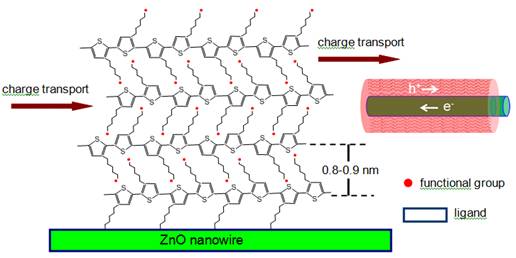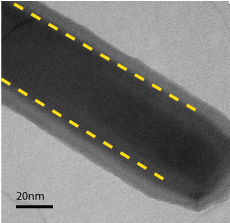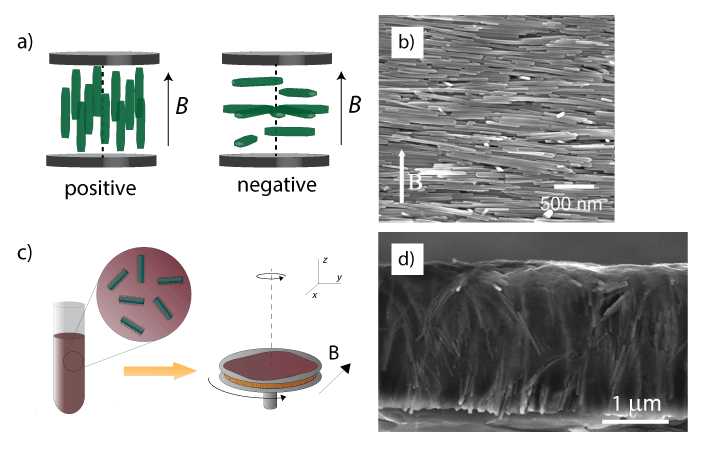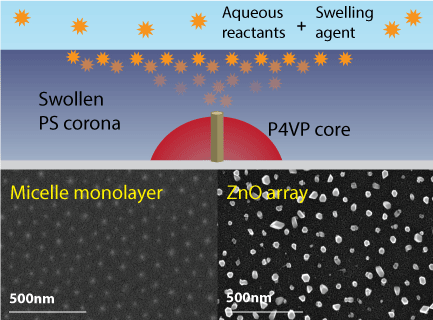|
Graduate Student Office: 226 Mason Lab Phone: (203) 436-4059
|
PhD Candidate in Chemical Engineering, Yale University, Department of Chemical & Environmental Engineering May 2012, M.S. in Chemical Engineering, Yale University May 2010, B.S. in Chemical Engineering, University of Connecticut , Department of Chemical, Materials, and Biomedical Engineering |
|
My research is focused on engineering directed- and self-assembly methods for controlling the ordering of nanomaterials in polymer composites across large length scales. I am motivated by improving the performance of nanomaterials-based devices through reliably matching the physically relevant length scales of quantum particle transport across device-relevant areas (>1cm.) Ordered bulk heterojunction (OBHJ) photovoltaics (Figure 1) serve as a model system for investigation. Significant improvements in power conversion efficiency are possible based on the ability to control the spacing of donor-acceptor domains within 20-40nm, driven by typical charge transport lengths in conjugated polythiophenes. Enlisting ZnO nanorods as a superior electron transporting material compared to typical organic species, one can imagine the formation of well-ordered arrays where nanowire periodicity in a composite film exactly matches the relevant transport dimensions.
Figure 1: Ordered bulk heterojunction schematic showing an array of vertically-aligned nanoparticles (green) interpenetrated with optically-active conjugated polymer (pink.) Primary directions of my current work are:
Figure 2: Schematic of ZnO-polythiophene core-shell composite structure, using side chain-on grafting for improved charge transport with HR-TEM image of nanocomposite showing core-shell structure. 2) Development of a method for magnetic field-assisted directed assembly of bulk ZnO nanowires into vertically-ordered arrays in polythiophene thin films (Figure 3), or magnetic alignment of core-shell hybrids for close-packed arrays. The first case is depicted below.
Figure 3: (a) Co-doped ZnO nanowires exhibit negative magnetic anisotropy and thus degeneracy in the free energy minimum orientation in a static field. (b) Drying dispersions of nanowires in a static field produces films of nanowires well-aligned in-plane due to dominant surface tension forces. (c) Rotational annealing of nanowire-polymer dispersions in a magnetic field during while drying permits selection of the out-of-plane orientation. (d) Film of nanowires perpendicularly aligned in photovoltaic polymer achieved through rotational annealing under tailored solvent atmosphere. 3) Solution-based block copolymer templating of solvothermally-prepared ZnO forests for controlled spatial density and nanowire dimension.
Figure 4: ZnO nanowires can be hydrothermally grown directly through hydrophilic cores of amiphiphilic block copolymer micelle monolayers. Doping the hydrothermal growth solution with a small molecule swelling agent, the hydrophobic core swells to permit controlled access of aqueous precursors to the hydrophilic core which shuttles them to an underlying seed layer. SEM images depict a ZnO nanorod array grown from the corresponding micelle template in a single-step hydrothermal templating and growth process. b. Study of P3HT:ZnO and P3HT/PCBM:ZnO bulk heterojunction device performance as a function of nanowire spacing and volume fraction. Other areas of interest: lyotropic liquid crystals, dilute magnetic semiconducting oxides, surfactant self-assembly, spectroscopy, photovoltaics |
|
|
|
While at UConn, I worked in the Institute of Materials Science as an undergraduate researcher in the lab of Steven Suib and later in the lab of Fotios Papadimitrakopoulos. My work focused on developing methods for controlled ZnO nanoparticle synthesis and chirality-induced separation of single-walled carbon nanotubes for sensing applications. |
|
|
|
|
|
|
|





